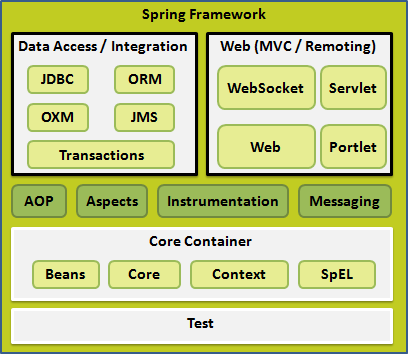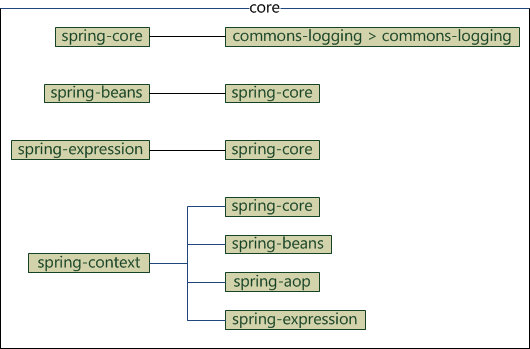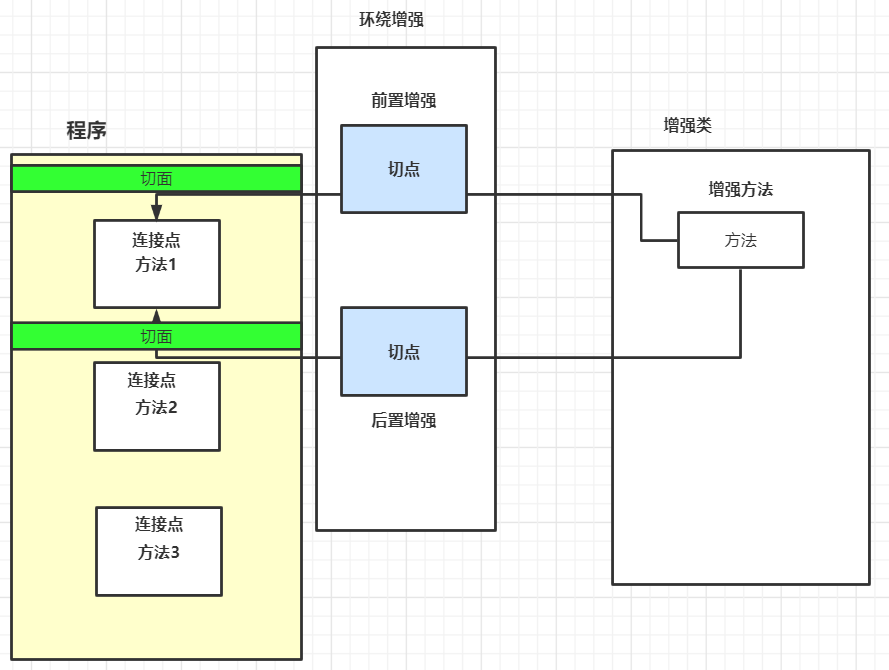spring
spring框架介绍
传统项目的架构
在传统的项目中,一般遵循MVC开发模型。
- view层与用户进行交互,显示数据或者将数据传输给view层。
- 在controller层创建service层对象,调用service层中业务方法。
- 在service层创建dao层对象,调用dao层中操作数据的方法。
- dao层进行具体的数据库操作
架构图

spring的核心组件

核心容器
核心容器由 spring-core,spring-beans,spring-context,spring-context-support和spring-expression(SpEL,Spring 表达式语言,Spring Expression Language)等模块组成,它们的细节如下:
- spring-core 模块提供了框架的基本组成部分,包括 IoC 和依赖注入功能。
- spring-beans 模块提供 BeanFactory,工厂模式的微妙实现,它移除了编码式单例的需要,并且可以把配置和依赖从实际编码逻辑中解耦。
- context 模块建立在由 core和 beans 模块的基础上建立起来的,它以一种类似于 JNDI 注册的方式访问对象。Context 模块继承自 Bean 模块,并且添加了国际化(比如,使用资源束)、事件传播、资源加载和透明地创建上下文(比如,通过 Servelet 容器)等功能。Context 模块也支持 Java EE 的功能,比如 EJB、JMX 和远程调用等。ApplicationContext 接口是 Context 模块的焦点。spring-context-support 提供了对第三方库集成到 Spring 上下文的支持,比如缓存(EhCache, Guava, JCache)、邮件(JavaMail)、调度(CommonJ, Quartz)、模板引擎(FreeMarker, JasperReports, Velocity)等。
- spring-expression 模块提供了强大的表达式语言,用于在运行时查询和操作对象图。它是 JSP2.1 规范中定义的统一表达式语言的扩展,支持 set 和 get 属性值、属性赋值、方法调用、访问数组集合及索引的内容、逻辑算术运算、命名变量、通过名字从 Spring IoC 容器检索对象,还支持列表的投影、选择以及聚合等。
依赖关系图

数据访问/集成
数据访问/集成层包括 JDBC,ORM,OXM,JMS 和事务处理模块,它们的细节如下:
(注:JDBC=Java Data Base Connectivity,ORM=Object Relational Mapping,OXM=Object XML Mapping,JMS=Java Message Service)
- JDBC 模块提供了 JDBC 抽象层,它消除了冗长的 JDBC 编码和对数据库供应商特定错误代码的解析。
- ORM 模块提供了对流行的对象关系映射 API 的集成,包括 JPA、JDO 和 Hibernate 等。通过此模块可以让这些 ORM 框架和 spring的其它功能整合,比如前面提及的事务管理。
- OXM 模块提供了对 OXM 实现的支持,比如 JAXB、Castor、XML Beans、JiBX、XStream 等。
- JMS 模块包含生产(produce)和消费(consume)消息的功能。从 Spring 4.1 开始,集成了 spring-messaging 模块。
- 事务模块为实现特殊接口类及所有的 POJO 支持编程式和声明式事务管理。(注:编程式事务需要自己写 beginTransaction()、commit()、rollback() 等事务管理方法,声明式事务是通过注解或配置由 spring 自动处理,编程式事务粒度更细)
web层
- Web 层由 Web,Web-MVC,Web-Socket 和 Web-Portlet 组成,它们的细节如下:
- Web 模块提供面向 web 的基本功能和面向 web 的应用上下文,比如多部分(multipart)文件上传功能、使用 Servlet 监听器初始化 IoC 容器等。它还包括 HTTP 客户端以及 Spring 远程调用中与 web 相关的部分。
- Web-MVC 模块为 web 应用提供了模型视图控制(MVC)和 REST Web服务的实现。Spring 的 MVC 框架可以使领域模型代码和 web 表单完全地分离,且可以与 Spring 框架的其它所有功能进行集成。
- Web-Socket 模块为 WebSocket-based 提供了支持,而且在 web 应用程序中提供了客户端和服务器端之间通信的两种方式。
- Web-Portlet 模块提供了用于 Portlet 环境的 MVC 实现,并反映了 spring-webmvc 模块的功能。
其他
- 还有其他一些重要的模块,像 AOP,Aspects,Instrumentation,Web 和测试模块,它们的细节如下:
- AOP 模块提供了面向方面(切面)的编程实现,允许你定义方法拦截器和切入点对代码进行干净地解耦,从而使实现功能的代码彻底的解耦出来。使用源码级的元数据,可以用类似于.Net属性的方式合并行为信息到代码中。
- Aspects 模块提供了与 AspectJ 的集成,这是一个功能强大且成熟的面向切面编程(AOP)框架。
- Instrumentation 模块在一定的应用服务器中提供了类 instrumentation 的支持和类加载器的实现。
- Messaging 模块为 STOMP 提供了支持作为在应用程序中 WebSocket 子协议的使用。它也支持一个注解编程模型,它是为了选路和处理来自 WebSocket 客户端的 STOMP 信息。
- 测试模块支持对具有 JUnit 或 TestNG 框架的 Spring 组件的测试。
Bean标签的属性介绍
id
- 是 bean的唯一标识 一个bean,其id 值只能有一个 。整个IOC 容器id 值不允许重复,使用名称作为key
name
- 一个bean的名称,可以存在多个,多个之间使用逗号分隔。不论bean有没有定义name属性,默认id都会当做name。
class
- bean的具体的类型,包名和类名组成。
scope
- bean的作用域
- prototype :非单例,每次获取都会创建一个新的bean对象。
- singleton : 单例,多次获取永远同一个bean, 默认值。
- request : 一次请求,基于web项目的bean的作用域。
- session : 一次会话,基于web项目的bean的作用域。
lazy-init
- 延迟初始化,默认只要加载了配置文件。bean对象就会被初始化,lazy-init则是获取时才会初始化。只针对单例模式有效,非单例每次获取都会创建,没有延迟初始化的意义
depends-on
- 初始化时依赖的对象,当前对象初始化前需先初始化depends-on指定的对象
init-method
- 对象初始化后,调用的方法
destroy-method
- 对象销毁时,调用的方法
autowire
属性自动装配
byName 根据属性名称装配
byType 根据类型装配
autowire-candidate
是否允许作为自动装配的候选项
true 作为自动装配的候选项
false 不作为自动装配的候选项
primary
- 优先使用该bean,因为Spring需要支持使用类型查找对象,在一个大类型下,可能存在多个小类型。如果根据大类型装配属性时,不知道使用哪个具体的对象,则可以根据primary设置优先级。
Bean对象创建的方法
构造方法创建
<bean id="user" class="com.abc.domian.User" />
静态工厂创建
<!--
id : bean 的唯一标识
class : 工厂类
factory-method : 工厂方法
-->
<bean id="user2" class="com.abc.factory.UserStaticFactory" factory-method="getObj" />
非静态工厂创建
<!--
非静态工厂创建对象
在非静态工厂中,创建对象的方法是非静态方法。非静态方法的执行,首先需要该类对象
注意: 使用非静态工厂创建对象,首先需要创建工厂类对象
-->
<!-- 工厂类对象 -->
<bean id="userFactory" class="com.abc.factory.UserFactory" />
<!-- 使用非静态工厂创建对象 -->
<!--
factory-bean : 非静态工厂对象
factory-method : 创建对象的非静态方法
-->
<bean id="user3" factory-bean="userFactory" factory-method="getObj" />
注解创建
组件注解
@Component
表示该类为一个被Spring管理的组件。但是,由于在开发中为了让代码的可读性更高。
Spring基于分层思想,将需要创建的组件分为以下几类:
@Controller
@Controller注解,标识该类是controller层的类。并且,注意在使用SpringMVC时,所有的Constroller,必须使用@Controller注解。
@Service
@Service注解,标识该类是业务层的类。
@Respository
@Respository注解,标识该类是操作数据层的类。
注解使用步骤
在spring的核心配置文件中,开启注解扫描,让Spring将被注解修饰的类,创建对相关。
<!-- 开启组件扫描 --> <context:component-scan base-package="com.abc.*" />将需要交给spring管理的类上面标上对应的注解
import org.springframework.stereotype.Component; @Component public class Person { public Person(){ System.out.println("Person的构造方法........."); } }
ioc属性注入
构造方法属性注入
<?xml version="1.0" encoding="UTF-8"?>
<beans xmlns="http://www.springframework.org/schema/beans"
xmlns:xsi="http://www.w3.org/2001/XMLSchema-instance"
xsi:schemaLocation="http://www.springframework.org/schema/beans http://www.springframework.org/schema/beans/spring-beans.xsd">
<!-- 无参构造方法 -->
<bean class="com.abc.domain.User" />
<!--
有参数的构造方法
此时是2个参数的构造方法
index : 参数下标 从 0开始
value : 属性的值
-->
<bean id="user2" class="com.abc.domain.User" >
<constructor-arg index="0" value="1001" />
<constructor-arg index="1" value="韩梅梅" />
</bean>
<!-- 有参数的构造方法
使用index下标查找 属性 存在问题 都只有一个参数 则默认使用后面的构造方法
可以使用 type 指定参数的类型
更推荐 使用name属性 : name表示构造器中参数的名称
-->
<bean id="user3" class="com.abc.domain.User">
<constructor-arg index="0" value="1001" type="java.lang.Integer" />
</bean>
<bean id="user4" class="com.abc.domain.User">
<constructor-arg name="name" value="韩梅梅" />
</bean>
</beans>
set方法属性注入
<?xml version="1.0" encoding="UTF-8"?>
<beans xmlns="http://www.springframework.org/schema/beans"
xmlns:xsi="http://www.w3.org/2001/XMLSchema-instance"
xsi:schemaLocation="http://www.springframework.org/schema/beans http://www.springframework.org/schema/beans/spring-beans.xsd">
<!--
使用set方法进行属性注入
property 表示属性
name : 表示属性对应的set方法名,去掉set前缀,首字母小写。并不是真正的属性名
-->
<bean id="student1" class="com.abc.domain.Student">
<property name="studentId" value="1001" />
</bean>
</beans>
注解属性注入
在spring中,为了简化属性的注入,Spring提供注解:**@Autowired**,Spring会自动从IOC容器中,为这个属性查找相应类型的值,进行注入。
public class Student { public Integer id; public String name; @Autowired //使用注解自动注入 //User 对象 public User user; public void setStudentId(Integer id) { System.out.println("set方法被调用了............"); this.id = id; } /* public void setUser(User user) { this.user = user; }*/ }注意:在使用自动注入时,可以在bean标签上,配置autowire,但是此时必须有该属性的set方法,**@Autowired**注解,是不需要set方法的。
如果是在xml中注入对象,值使用ref属性。value属性,只支持boolean,数字,字符串等。
AOP代理
aop简介
- 代理:静态代理
- 静态代理,每个被代理类都需要创建对应的代理类。随着程序的扩展,代理类也会增多,臃肿,维护量变多,为了解决这个问题,Java中,提供了动态代理技术,开发者不需要自己定义代理类,代理类由JDK动态的创建,开发只需要指定被代理的类即可。
动态代理
JDK动态代理
proxy
该类提供了方法创建代理类和代理类的对象的方法
创建一个代理类并返回代理类对象
static Object newProxyInstance(ClassLoader loader, Class[] interfaces, InvocationHandler h) loader :// 类加载器,指定类加载器,是为了精确的定位类 interfaces : // 接口Class类,使用JDK的反射,必须要有接口 h :InvocationHandler ,//代理的处理器,每个代理类都有一个关联的处理器InvocationHandler
是每个代理类对应的处理器
Object invoke(Object proxy,Method method,Object[] args) Object //方法调用的返回值,可以作为被代理的方法调用的返回值 proxy : //代理类对象 method : //目标类中被代理的方法 args : //目标类中被代理的方法的运行参数例子如下
//目标接口类 public interface Agent { void rent(); void rent2(int i); } //目标类 public class FangDong implements Agent{ @Override public void rent() { System.out.println("租房1000元"); } @Override public void rent2(int i) { System.out.println("第二套房"); } } //代理增强类 public class MyRent implements MethodBeforeAdvice { @Override public void before(Method method, Object[] objects, Object o) throws Throwable { System.out.println("增加500元"); } }
cglib动态代理
MethodInterceptor
cglib中,提供的对方法执行拦截的接口。其中intercept是对具体方法进行拦截处理的方法。
public Object intercept(Object obj, java.lang.reflect.Method method, Object[] args, MethodProxy proxy) Object :// 方法执行返回的结果 obj ://增强类的对象 method ://目标方法 proxy ://用于回调的方法的对象例子如下
//代理增强类 public class MyMethodInterceptor implements MethodInterceptor { @Override public Object intercept(Object o, Method method, Object[] objects, MethodProxy methodProxy) throws Throwable { System.out.println("多收5000元租金"); return methodProxy.invokeSuper(o,objects); } } //目标类 public class Fangdong { public void sent() { System.out.println("房子出租1000元"); } } //测试类 public class App { public static void main(String[] args) { Enhancer enhancer = new Enhancer(); enhancer.setSuperclass(Fangdong.class); enhancer.setCallback(new MyMethodInterceptor()); Fangdong fangdong = (Fangdong) enhancer.create(); fangdong.sent(); } }
spring的AOP配置
AOP的相关概念
- **连接点(JoinPoint)**:所谓连接点是指那些被拦截的点,而spring中这些点就是指方法,因为spring只支持方法类型的连接点。
- **切入点(PointCut)**:所谓切入点就是指我们要对那些JoinPoint进行拦截的定义,指的是具体的拦截的位置
- 增强/通知(Advice) : 增强就是对具体的连接点进行扩展的功能。由于一般对方法进行增强,分为在方法前执行或者方法后,或者发生异常执行等等,所以增强被分为:前置增强(前置通知)、后置增强(后置通知)、环绕通知(环绕增强)、异常增强(异常通知)
- **引介(Introduction)**:引介是一种特殊的Advice,在不修改代码的前提下,引介可以在运行期为类动态的添加一些方法或Field.
- 目标(Target) :被代理的类(需要增强类)
- 织入(Weaving) :把Advice应用到Target的过程
- 代理(Proxy):使用AOP配置后产生的代理类
- 切面(Aspect):切点和增强整合形成了切面
AOP增强图

前置增强-MethodBeforeAdvice
后置增强-AfterReturningAdvice
环绕增强-MethodInterceptor
异常增强-ThrowsAdvice
aop配置
<?xml version="1.0" encoding="UTF-8"?> <beans xmlns="http://www.springframework.org/schema/beans" xmlns:xsi="http://www.w3.org/2001/XMLSchema-instance" xmlns:aop="http://www.springframework.org/schema/aop" xsi:schemaLocation="http://www.springframework.org/schema/beans http://www.springframework.org/schema/beans/spring-beans.xsd http://www.springframework.org/schema/aop https://www.springframework.org/schema/aop/spring-aop.xsd"> <!-- 定义目标类对象 --> <bean id="targetClass" class="com.abc.impl.TargetClassImpl" /> <!-- 定义增强类对象 前置增强类 --> <bean id="myBeforeAdvice" class="com.abc.advice.MyBeforeAdvice" /> <!-- 定义增强类对象 后置增强 --> <bean id="myAfterAdvice" class="com.abc.advice.MyAfterAdvice" /> <!-- 定义增强类 环绕增强 --> <bean id="myAroundAdvice" class="com.abc.advice.MyAroundAdvice" /> <!-- 定义增强类 异常增强类 --> <bean id="myExceptionAdvice" class="com.abc.advice.MyExceptionAdvice" /> <!-- 进行织入 --> <aop:config> <!-- id : 连接点的唯一标识 expression : 连接点的表达式 execution(* 包名.类名.方法名(..)) * 指任意字符 .. 表示参数可以是任意个 --> <aop:pointcut id="beforePoint" expression="execution(* com.abc.impl.TargetClassImpl.targetMethod(..))"/> <!-- 后置增强的切点 --> <aop:pointcut id="afterPoint" expression="execution(* com.abc.impl.TargetClassImpl.afterTargetMethod(..))"/> <!-- 环绕增强的切点 --> <aop:pointcut id="aroundPoint" expression="execution(* com.abc.impl.TargetClassImpl.aroundTargetMethod(..))"/> <!-- 异常增强的切点 --> <aop:pointcut id="exceptionPoint" expression="execution(* com.abc.impl.TargetClassImpl.runException(..))"/> <!-- 织入 将增强和连接点 结合 --> <aop:advisor advice-ref="myBeforeAdvice" pointcut-ref="beforePoint" /> <!-- 织入 后置增强的织入 --> <aop:advisor advice-ref="myAfterAdvice" pointcut-ref="afterPoint" /> <!-- 织入 环绕增强的织入 --> <aop:advisor advice-ref="myAroundAdvice" pointcut-ref="aroundPoint" /> <!-- 织入 异常增强的织入 --> <aop:advisor advice-ref="myExceptionAdvice" pointcut-ref="exceptionPoint" /> </aop:config> </beans>AspectJ框架AOP配置
编写增强类
public class MyAdvice { public void beforAdvice(){ System.out.println("前置增强的方法"); } public void afterAdvice(String name,String rs){ System.out.println("后置增强的方法"); } public void aroundAdvice(ProceedingJoinPoint joinPoint){ System.out.println("前置增强"); try { joinPoint.proceed(); } catch (Throwable throwable) { throwable.printStackTrace(); } System.out.println("后置增强"); } /** * 异常增强 * @param exception */ public void exceptionAdvice(Exception exception){ System.out.println("异常增强!"); } }编写目标类
public interface ITargetClass { /** * 前置增强的方法 */ void beforeMethod(); /** * 后置增强的方法 */ String afterMethod(String name1); /** * 环绕增强的方法 */ void aroundMethod(); /** * 异常增的方法 */ void runExceptionMethod();实现类
public class TargetClassImpl implements ITargetClass { @Override public void beforeMethod() { System.out.println("待前置增强--------beforeMethod"); } @Override public String afterMethod(String name) { System.out.println("待后置增强--------afterMethod"); return "韩梅梅"; } @Override public void aroundMethod() { System.out.println("待环绕增强--------aroundMethod"); } @Override public void runExceptionMethod() { System.out.println("待异常增强--------runExceptionMethod"); int m = 0; int n = 100/m; } }配置AspectJ的增强配置
<?xml version="1.0" encoding="UTF-8"?> <beans xmlns="http://www.springframework.org/schema/beans" xmlns:xsi="http://www.w3.org/2001/XMLSchema-instance" xmlns:aop="http://www.springframework.org/schema/aop" xsi:schemaLocation="http://www.springframework.org/schema/beans http://www.springframework.org/schema/beans/spring-beans.xsd http://www.springframework.org/schema/aop https://www.springframework.org/schema/aop/spring-aop.xsd"> <!-- 定义增强的目标类对象 --> <bean id="targetClass" class="com.abc.impl.TargetClassImpl" /> <!-- 定义增强类的对象 --> <bean id="myAdvice" class="com.abc.advice.MyAdvice" /> <!-- 进行AOP配置 --> <aop:config> <!-- 前置切点 --> <!-- aop:before : aspectJ中 前置增强的配置 method : 当前增强类中前置增强的方法 方法名 pointcut-ref : 增强连接点 --> <aop:pointcut id="beforPoint" expression="execution(* com.abc.impl.TargetClassImpl.beforeMethod(..)) " /> <!-- 后置切点 --> <!-- args 配置被增强的方法的参数名称 --> <aop:pointcut id="afterPoint" expression="execution(* com.abc.impl.TargetClassImpl.afterMethod(..)) and args(name)" /> <!-- 环绕切点 --> <aop:pointcut id="aroundPoint" expression="execution(* com.abc.impl.TargetClassImpl.aroundMethod(..))" /> <!-- 异常切点 --> <aop:pointcut id="exceptionPoint" expression="execution(* com.abc.impl.TargetClassImpl.runExceptionMethod(..))" /> <aop:aspect ref="myAdvice"> <!-- <aop:before method="beforAdvice" pointcut-ref="beforPoint" />--> <!-- arg-names :后置增强中增强的方法的参数名称 注意: name 也是被增强的方法的参数名称 参数名称要一致 returning :返回结果的参数名称 --> <aop:after-returning method="afterAdvice" pointcut-ref="afterPoint" arg-names="name,rs" returning="rs" /> <!--<aop:around method="aroundAdvice" pointcut-ref="aroundPoint" />--> <!-- throwing : 接收异常参数的名称 --> <aop:after-throwing method="exceptionAdvice" pointcut-ref="exceptionPoint" throwing="exception" /> </aop:aspect> </aop:config> </beans>
声明式事务
xml版本事务
xml事务配置
<?xml version="1.0" encoding="UTF-8"?> <beans xmlns="http://www.springframework.org/schema/beans" xmlns:xsi="http://www.w3.org/2001/XMLSchema-instance" xmlns:context="http://www.springframework.org/schema/context" xmlns:tx="http://www.springframework.org/schema/tx" xmlns:aop="http://www.springframework.org/schema/aop" xsi:schemaLocation="http://www.springframework.org/schema/beans http://www.springframework.org/schema/beans/spring-beans.xsd http://www.springframework.org/schema/context https://www.springframework.org/schema/context/spring-context.xsd http://www.springframework.org/schema/tx http://www.springframework.org/schema/tx/spring-tx.xsd http://www.springframework.org/schema/aop https://www.springframework.org/schema/aop/spring-aop.xsd"> <!--关联数据库的配置信息--> <context:property-placeholder location="classpath:db.properties"/> <!--注入service--> <bean id="accountService" class="com.abc.service.impl.AccountServiceImpl" > </bean> <!--注入数据源--> <bean id="dataSource" class="com.alibaba.druid.pool.DruidDataSource" init-method="init" destroy-method="close"> <property name="driverClassName" value="${db.driver}"/> <property name="username" value="${db.username}"/> <property name="password" value="${db.password}"/> <property name="url" value="${db.url}"/> </bean> <bean id="configuration" class="org.apache.ibatis.session.Configuration"> <!-- 指定日志工具 --> <property name="logImpl" value="org.apache.ibatis.logging.log4j.Log4jImpl" /> <!-- 配置缓存 --> <property name="cacheEnabled" value="true" /> <!--懒加载--> <property name="aggressiveLazyLoading" value="false"/> <property name="lazyLoadingEnabled" value="true"/> <property name="lazyLoadTriggerMethods" value="clone"/> </bean> <!--注入sqlSessionFactory工厂对象--> <bean id="sessionFactory" class="org.mybatis.spring.SqlSessionFactoryBean"> <!--配置属性 MyBatis 的主配置文件--> <property name="configuration" ref="configuration"/> <!--配置数据源--> <property name="dataSource" ref="dataSource"/> <!--配置类的别名--> <property name="typeAliasesPackage" value="com.abc.domain"/> <!--配置关联mapper的xml 要想省掉 它,必须要求,mapper的接口和xml文件编译之后在一个文件夹中--> <!-- <property name="mapperLocations" value="classpath*:**/*Mapper.xml"/>--> <!--配置分页插件--> <property name="plugins"> <array> <bean class="com.github.pagehelper.PageInterceptor"> <property name="properties"> <value> helperDialect=mysql reasonable=true autoRuntimeDialect=true </value> </property> </bean> </array> </property> </bean> <!--配置Mapper接口的扫描器 这个扫描器 是专门 扫描 mapper 接口所在的包,给这些mapper接口 创建代理对象 里面的参数设置 包的设置必须是mapper的包 --> <bean class="org.mybatis.spring.mapper.MapperScannerConfigurer"> <property name="basePackage" value="com.bjpowernode.mapper"/> </bean> <!-- aop 机制 通过面向切面编程的思想,给程序添加事务处理--> <!--配置事务处理器 相当于 我们以前写的 增强类--> <bean id="transactionManager" class="org.springframework.jdbc.datasource.DataSourceTransactionManager"> <!--配置数据源--> <property name="dataSource" ref="dataSource"/> </bean> <!--对什么方法 做什么增强--> <tx:advice id="advice" transaction-manager="transactionManager"> <tx:attributes> <!-- name : 进行数据库操作方法的名称 add* 表示 add开头的方法 * 指代任意字符 propagation : 事务传播性 面试重点 read-only : 只读事务 默认 false rollback-for : 指定回滚的异常 默认是 RunTimeException 下的异常会自动回滚 no-rollback-for : 不回滚的异常 timeout : 事务的超时时间 isolation : 事务隔离级别 面试重点 | 1. 读未提交 | 2. 读已提交 | 3. 可重复读 | 4. 串行化 --> <tx:method name="find*" read-only="true"/> <tx:method name="get*" read-only="true"/> <tx:method name="select*" read-only="true"/> <tx:method name="query*" read-only="true"/> <tx:method name="list*" read-only="true"/> <!--isolation="DEFAULT" 隔离级别 默认隔离级别 不用写 propagation 传播行为 默认的--> <tx:method name="*" propagation="REQUIRED" isolation="DEFAULT"/> </tx:attributes> </tx:advice> <!--aop 的配置--> <aop:config> <!--切入点--> <aop:pointcut id="pointcut" expression="execution(* com.abc.service.impl.*Impl.*(..))"/> <!--织入--> <aop:advisor advice-ref="advice" pointcut-ref="pointcut"/> </aop:config> </beans>注解版声明事务,配置
<?xml version="1.0" encoding="UTF-8"?> <beans xmlns="http://www.springframework.org/schema/beans" xmlns:xsi="http://www.w3.org/2001/XMLSchema-instance" xmlns:context="http://www.springframework.org/schema/context" xmlns:tx="http://www.springframework.org/schema/tx" xmlns:aop="http://www.springframework.org/schema/aop" xsi:schemaLocation="http://www.springframework.org/schema/beans http://www.springframework.org/schema/beans/spring-beans.xsd http://www.springframework.org/schema/context https://www.springframework.org/schema/context/spring-context.xsd http://www.springframework.org/schema/tx http://www.springframework.org/schema/tx/spring-tx.xsd http://www.springframework.org/schema/aop https://www.springframework.org/schema/aop/spring-aop.xsd"> <!--关联数据库的配置信息--> <context:property-placeholder location="classpath:db.properties"/> <!--注入service--> <bean id="accountService" class="com.abc.service.impl.AccountServiceImpl" > </bean> <!--注入数据源--> <bean id="dataSource" class="com.alibaba.druid.pool.DruidDataSource" init-method="init" destroy-method="close"> <property name="driverClassName" value="${db.driver}"/> <property name="username" value="${db.username}"/> <property name="password" value="${db.password}"/> <property name="url" value="${db.url}"/> </bean> <bean id="configuration" class="org.apache.ibatis.session.Configuration"> <!-- 指定日志工具 --> <property name="logImpl" value="org.apache.ibatis.logging.log4j.Log4jImpl" /> <!-- 配置缓存 --> <property name="cacheEnabled" value="true" /> <!--懒加载--> <property name="aggressiveLazyLoading" value="false"/> <property name="lazyLoadingEnabled" value="true"/> <property name="lazyLoadTriggerMethods" value="clone"/> </bean> <!--注入sqlSessionFactory工厂对象--> <bean id="sessionFactory" class="org.mybatis.spring.SqlSessionFactoryBean"> <!--配置属性 MyBatis 的主配置文件--> <property name="configuration" ref="configuration"/> <!--配置数据源--> <property name="dataSource" ref="dataSource"/> <!--配置类的别名--> <property name="typeAliasesPackage" value="com.abc.domain"/> <!--配置关联mapper的xml 要想省掉 它,必须要求,mapper的接口和xml文件编译之后在一个文件夹中--> <!-- <property name="mapperLocations" value="classpath*:**/*Mapper.xml"/>--> <!--配置分页插件--> <property name="plugins"> <array> <bean class="com.github.pagehelper.PageInterceptor"> <property name="properties"> <value> helperDialect=mysql reasonable=true autoRuntimeDialect=true </value> </property> </bean> </array> </property> </bean> <!--配置Mapper接口的扫描器 这个扫描器 是专门 扫描 mapper 接口所在的包,给这些mapper接口 创建代理对象 里面的参数设置 包的设置必须是mapper的包 --> <bean class="org.mybatis.spring.mapper.MapperScannerConfigurer"> <property name="basePackage" value="com.abc.mapper"/> </bean> <!-- aop 机制 通过面向切面编程的思想,给程序添加事务处理--> <!--配置事务处理器 相当于 我们以前写的 增强类--> <bean id="transactionManager" class="org.springframework.jdbc.datasource.DataSourceTransactionManager"> <!--配置数据源--> <property name="dataSource" ref="dataSource"/> </bean> <!--事务注解驱动--> <tx:annotation-driven transaction-manager="transactionManager"/> </beans>service代码
@Transactional(propagation = Propagation.REQUIRED,isolation = Isolation.DEFAULT) public class AccountServiceImpl implements IAccountService { @Autowired private AccountMapper accountMapper; @Transactional // 方法上添加事务 或者类上添加事务注解 都可以 // 添加在类上,表示类中的所有方法都有事务 // 添加在方法上,表示该方法有事务 public void transMoney(String sourceName, String targetName, BigDecimal money) { // 开启事务 accountMapper.subMoney(sourceName,money); int i = 1/0; accountMapper.addMoney(targetName,money); // 提交事务 // 回滚事务 } }
事务的传播性
| 传播级别 | 说明 | 描述 |
|---|---|---|
| REQUIRED | 必须的 | 默认值,表示当前若存在事务则使用当前事务,若不存在则创建一个新的事务 |
| SUPPORTS | 支持的 | 表示当前若存在事务则在当前事务中执行,若不存在则在非事务中执行 |
| MANDATORY | 强制性的 | 表示必须在事务中执行,若当前没有事务则抛出异常 |
| NEVER | 绝不 | 表示一定不在事务中的执行,若当前存在事务则报错 |
| NESTED | 嵌套的 | 若当前存在事务,则创建一个子事务,嵌套在当前事务中,注意,外层事务出现异常会回滚子事务,子事务出现异常,不影响外层事务 |
| REQUIRES_NEW | 必须新建 | 表示无论当前是否存在事务,都会创建一个新的事务,在新的事务中执行 只支持JtaTransactionManager |
| NOT_SUPPORTED | 不支持事务 | 表示不论当前是否存在事务,都不会在事务中执行。只支持JtaTransactionManager |



